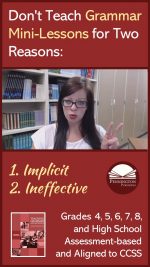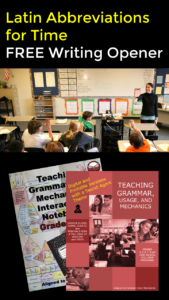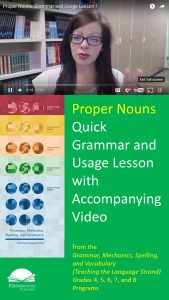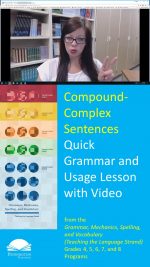Don’t Teach Grammar Mini-Lessons
Don’t teach grammar mini-lessons for two reasons: this instructional methodology is implicit and ineffective.
Currently, the top Google search for “new research on teaching grammar” brings up this article from The Atlantic, written by Professor Michelle Navarre Cleary:
The Wrong Way to Teach Grammar?
A century of research shows that traditional grammar lessons—those hours spent diagramming sentences and memorizing parts of speech—don’t help and may even hinder students’ efforts to become better writers. Yes, they need to learn grammar, but the old-fashioned way does not work.
Case settled? Not exactly. In educational research it is much easier to disprove than to prove. Educational researchers frequently employ the null hypothesis in their experimental design. In a nutshell, a grammar program research study might have the following hypothesis: “There is no statistical significance between the achievement of grade 8 students taught with such and such grammar program and those not taught with said grammar program as measured by such and such assessment over such and such a period of time.”
By design, any findings would have to be extremely limited and the control group, unless unexposed to any literacy activities in hermetically-sealed isolation chambers, would have so many variables that any findings would be questionable. Such has been the case with the century of research on grammar and usage acquisition and its transfer to writing. Two separate issues, by the way.
What the good professor is advocating is learning grammar implicitly from reading and writing, especially the latter. She suggests mini-lessons in the context of writing as a superior method of writing instruction (Notice: not grammar instruction).
We know that grammar instruction that works includes teaching students strategies for revising and editing, providing targeted lessons on problems that students immediately apply to their own writing, and having students play with sentences like Legos, combining basic sentences into more complex ones. Often, surprisingly little formal grammar instruction is needed. Researcher Marcia Hurlow has shown that many errors “disappear” from student writing when students focus on their ideas and stop “trying to ‘sound correct.’”
These grammar mini-lessons are part and parcel of the implicit instructional approach: “If you do something over and over again, you’ll eventually stop making mistakes and get gooder at the task.” It’s akin to playing Monopoly for the first time without reading the rules. No, you don’t eventually learn to play by playing and being interrupted by occasional mini-lessons on what to do when passing “Go.”
What’s Wrong with the Implicit Approach in Mini-Lessons?
- It is simply inefficient. Waiting to teach a mini-lesson as students need the grammatical tool always comes with this advice: “When you notice that some of your students are having capitalization issues regarding article titles, pull a group of students needing the instruction and teach the relevant rules.” Of course, other students may need that same instruction, but have not yet evidenced the problems in writer mini-conferences with the teacher. Furthermore, why not teach the capitalization rules for all proper nouns. You know you are going to have to teach another mini-lesson next week on the capitalization of song and poem titles. Lastly, the beauty of the Common Core State Standards is the grade-level expectations and the mastery approach to learning. The CCSS Language Strand has quite explicit grammar, usage, and mechanics grade-level Standards.
- It is haphazard and disjointed. A traditional grammar approach provides explicit, planned instruction. An isolated mini-lesson on combining sentences by starting with a prepositional phrase will not make sense unless students have a solid foundation of subjects, predicates (a prepositional phrase never includes the subject or predicate), the characteristics of a phrase and a complete sentence, the role of commas with introductory phrases, etc. All other academic disciplines build upon foundations: no math teacher would do a mini-lesson on long division before teaching the multiplication tables.
- It does not connect to other language instruction. An isolated mini-lesson on semi-colons does not connect to related lessons on comma-conjunction rules, independent and dependent clauses, the use of phrases in lists, etc. The amount of scaffolding required to teach a mini-lesson on mis-use of the semi-colon is significant. Interestingly, the most popular approach to grammar, usage, and mechanics instruction, Daily Oral Language, is at the forefront of criticism by those favoring the mini-lesson approach for not connecting to other language instruction. See my article “Why Daily Oral Language (D.O.L.) Doesn’t Work” for more.
- It falsely teaches students that grammar is an editing skill alone. Aside from the sentence combining practice, advocates of the mini-lesson approach teaches students that grammar, usage, and mechanics instruction is all about mistakes, rather than about tools to enrich speaking and writing.
Why Are Grammar Mini-Lessons So Ineffective?
- There is no corroborating research. Those advocating the relegation of grammar, usage, and mechanics instruction to mini-lessons have zero research studies to confirm a positive correlation with this approach on either grammar or writing assessments. It’s easy to throw stones at traditional grammar approaches, but it does not follow that mini-lessons are the best and only alternatives. The professor in The Atlantic article only cites anecdotal evidence that learning grammar from writing does, indeed, work.
- We’ve been there and done that. Decades of ignoring explicit grammar instruction have not seen increased reading or writing ability in our students. The Common Core authors in Appendix A crush the notion that implicit instructional approaches produce better results than explicit ones. Hence, the unpopular (among grammar mini-lesson fans) inclusion of a separate Language Strand. Even the most recent National Council of Teachers of English (NCTE) position statement in the NCTE Guideline now stresses the importance of direct instruction in these areas (even including parts of speech and sentence diagramming) with the caveat that instruction must be connected to reading, writing, and speaking. Regarding instructional approaches, the NCTE position might surprise some die-hard anti-grammar fanatics.
- There is less grammar teaching in mini-center classrooms. It’s just true. Those who use mini-lessons devalue the important contributions that grammar, usage, and mechanics instruction bring to developing readers and writers. Or, as is often the case, teachers did not learn grammar as students and did not learn how to teach grammar, usage, and mechanics in teacher preparation classes. Grammar can be scary and teachers seek their own instructional comfort levels.
- This instructional philosophy trickles into other language instruction. The implicit instruction of grammar mini-lessons bleeds into other areas of language instruction. Typically, those who teach grammar mini-lessons follow suit in vocabulary instruction. Again, the days of teaching only vocabulary in context and assorted mini-lessons on context clues has not done the job. The Common Core State Standards require a variety of direct vocabulary instruction at each grade level to improve the academic language of our students. See an example of the Vocabulary Acquisition and Use Standards, again found in the Language Strand to see if these Standards are conducive to a mini-lesson approach (They are not). In reading instruction we abandoned the “whole to part” strategy years ago following the 1985 National Reading Panel Report with its reading research consistently supporting the explicit, systematic approach to reading development. Interestingly, many teachers who now teach direct vocabulary and reading instruction have hung on to the implicit approach to grammar, usage, and mechanics instruction.
- Not enough practice. William Van Cleave argued that mini-lessons rarely produced the amount of connected practice to master syntactic skills.
*****

Pennington Publishing Grammar Programs
Teaching Grammar, Usage, and Mechanics (Grades 4, 5, 6, 7, 8, and High School) are full-year, traditional, grade-level grammar, usage, and mechanics programs with plenty of remedial practice to help students catch up while they keep up with grade-level standards. Twice-per-week, 30-minute, no prep lessons in print or interactive Google slides with a fun secret agent theme. Simple sentence diagrams, mentor texts, video lessons, sentence dictations. Plenty of practice in the writing context. Includes biweekly tests and a final exam.
Grammar, Usage, and Mechanics Interactive Notebook (Grades 4‒8) is a full-year, no prep interactive notebook without all the mess. Twice-per-week, 30-minute, no prep grammar, usage, and mechanics lessons, formatted in Cornell Notes with cartoon response, writing application, 3D graphic organizers (easy cut and paste foldables), and great resource links. No need to create a teacher INB for student make-up work—it’s done for you! Plus, get remedial worksheets, biweekly tests, and a final exam.
Syntax in Reading and Writing is a function-based, sentence level syntax program, designed to build reading comprehension and increase writing sophistication. The 18 parts of speech, phrases, and clauses lessons are each leveled from basic (elementary) to advanced (middle and high school) and feature 5 lesson components (10–15 minutes each): 1. Learn It! 2. Identify It! 3. Explain It! (analysis of challenging sentences) 4. Revise It! (kernel sentences, sentence expansion, syntactic manipulation) 5. Create It! (Short writing application with the syntactic focus in different genre).
Get the Diagnostic Grammar, Usage, and Mechanics Assessments, Matrix, and Final Exam FREE Resource:
![]()
Grammar/Mechanics, Literacy Centers, Spelling/Vocabulary, Study Skills, Writing






